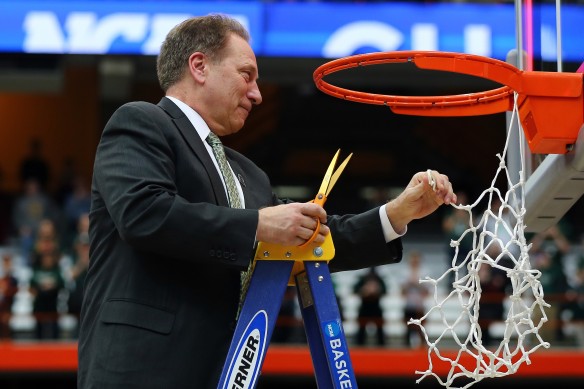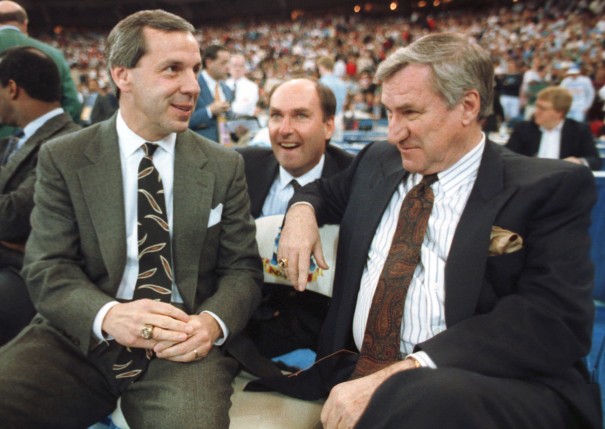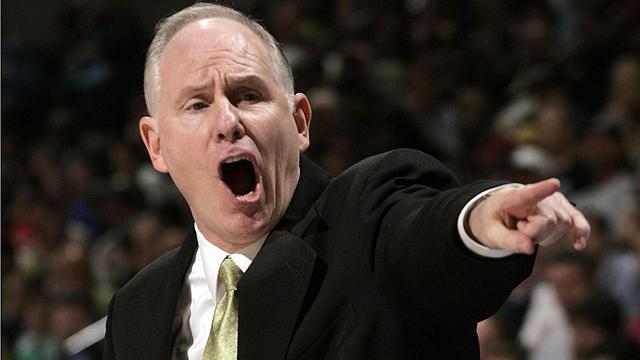The NCAA tournament bracket is such a big deal not just because teams want to know where they’re going and whom they’re playing. The more fundamental drama associated with a bracket involves the larger combinations of matchups — those which could happen, and those which will either be avoided or delayed.
The construction of the bracket inherently creates certain possibilities while excluding others. A separate segment of possibilities still exists, but is made more remote by the specific arrangement of teams.
We explore the possibilities created by the 2016 NCAA Tournament bracket, looking through the eyes of history to give you a sense of what will — or might — unfold in the coming weeks:

SYRACUSE, NY – MARCH 29: Head coach Tom Izzo of the Michigan State Spartans celebrates by cutting down the net after defeating the Louisville Cardinals 76 to 70 in overtime of the East Regional Final of the 2015 NCAA Men’s Basketball Tournament at Carrier Dome on March 29, 2015 in Syracuse, New York. (Photo by Elsa/Getty Images)
FRESH FACES OR FAMILIAR FIGURES?
This is a fascinating bracket in that it offers a realistic chance for a very new kind of Final Four… but a few members of the old guard stand in the way.
The odds of a relatively new Final Four team in the West Region are extremely good. As long as it’s not Duke, we’ll have a Final Four representative which hasn’t been to the big stage in over a decade.
In the Midwest Region, Michigan State is the only realistic impediment to a similar scenario. Butler and Syracuse aren’t exactly likely to crash this party.
The South and especially the East pose more formidable obstacles to a “Hey, where have you been the past decade?” version of the Final Four. In the South, Kansas and Villanova have both made this basketball bash within the past eight years. In the East, North Carolina, Kentucky, and West Virginia stand against Xavier and other aspiring challengers.
New or old? We’ll find out soon enough.

A great coach against a great player — that’s Rick Carlisle of Virginia against Hakeem Olajuwon in the 1984 Final Four national semifinals in Seattle’s Kingdome. This is the last time Virginia made the Final Four.
THE 30-YEAR ITCH
Among top-six seeds only:
A Final Four comprised solely of teams with a previous Final Four appearance but at least a 30-year drought since that breakthrough would be as follows: Virginia OR Iowa State OR Purdue; Notre Dame; California; and Oregon.
SWEET 16 REMATCHES
These were all Sweet 16 games from past NCAA tournaments. They could unfold again:
Kansas vs. California (1993).
Xavier vs. West Virginia (2008).
Gonzaga vs. Michigan State (2001).
Indiana vs. North Carolina (1984).
ROUND OF 32 COACHING REUNIONS
The round of 32 has a knack for pitting a coach against a former school or employer. It never seems to fail. (More research on this one would be fun for a stand-alone piece — maybe next year.)
Two examples this year:
Colorado-Kansas. CU coach Tad Boyle played at Kansas.
Michigan-West Virginia, if Michigan can win twice. John Beilein would coach against his former employer.

Roy Williams and Dean Smith at the 1991 Final Four in Indianapolis (with Jim Delany being way too happy about the moment in the background).
THREE-FOURTHS OF FOUR
Among top-six seeds only:
A number of previous Final Fours could regain three pieces this year. None appear to be able to recreate a whole Final Four.
The trio of “three-fourths” Final Fours:
Duke, Kansas and North Carolina, from 1991.
Michigan State, Duke, and Arizona or Maryland, from 2001.
Oklahoma, Indiana, and Maryland or Kansas, from 2002.
TWO DISTINCT DOUBLES
Of every top-6 seed in the 2016 Big Dance — in other words, the 24 top seeds in the bracket — only two have never been to the Final Four while also being led by a coach who has never been to the Final Four.
Several programs have one or the other (Notre Dame has been to the Final Four, but Mike Brey has not as a head coach; Miami has not been to the Final Four, but Jim Larranaga has, with George Mason in 2006), but only two lack both.
The answers: Texas A&M and Billy Kennedy; Xavier and Chris Mack.
FIRSTS AND THREES
Three top-3 seeds are in search of a first-ever Final Four and could all converge in early April: Miami in the South Region, Texas A&M in the West, and Xavier in the East. In the Midwest, Texas Tech and Gonzaga are seeded outside the top seven. Iowa State is the highest Midwest Region seed with the longest Final Four drought (1944).
HIGHER SEEDS, HIGHER HIGHS
The highest Final Four seed combination with four first-time Final Four coaches would be: 8.
Oregon and Virginia are 1 seeds. Xavier is a 2. California is a 4. If those four teams made it, their coaches — Dana Altman, Tony Bennett, Chris Mack, and Cuonzo Martin — would all be first-timers.
The second-highest seed combination, if none of the above four teams or coaches could be duplicated in a different combination: 17.
Texas A&M is a 3 with Billy Kennedy; Maryland is a 5 with Mark Turgeon; Notre Dame is a 6 with Mike Brey; and Utah is a 3 with Larry Krystkowiak.
FOUR-SOMES
The number of Final Four coaches by region:
The Midwest and West have 3 each; the East and South have 5 apiece.
FINALLY, ONE MORE FOUR-THOUGHT
The number of Final Fours reached by coaches in each region:
The South has only 6.
The Midwest has 12 — as many as Mike Krzyzewski has by himself.
The West has 14 — 12 of them by Coach K.
The East is the leader with 17. Roy Williams and John Calipari combine for 13… only one more than Coach K.
Did we say Coach K is ridiculous? No? Well, there’s more evidence that he is.


